2006 FORD F250 SUPER DUTY jump start
[x] Cancel search: jump startPage 2 of 312

Seating and Safety Restraints 90Seating 90
Safety restraints 97
Airbags 108
Child restraints 117
Tires, Wheels and Loading 129Tire Information 132
Tire Inflation 133
Vehicle loading 148
Trailer towing 155
Trailer Brake Controller-Integrated 159
Recreational towing 165
Driving 167Starting 167
Brakes 172
Transmission operation 176
Roadside Emergencies 202Getting roadside assistance 202
Hazard flasher switch 204
Fuel pump shut-off switch 204
Fuses and relays 205
Changing tires 214
Lug Nut Torque 225
Jump starting 226
Wrecker towing 232
Customer Assistance 234Reporting safety defects (U.S. only) 240
Cleaning 241Table of Contents
2
2006 F-250/350/450/550 (f23)
Owners Guide (post-2002-fmt)
USA (fus)
Page 202 of 312
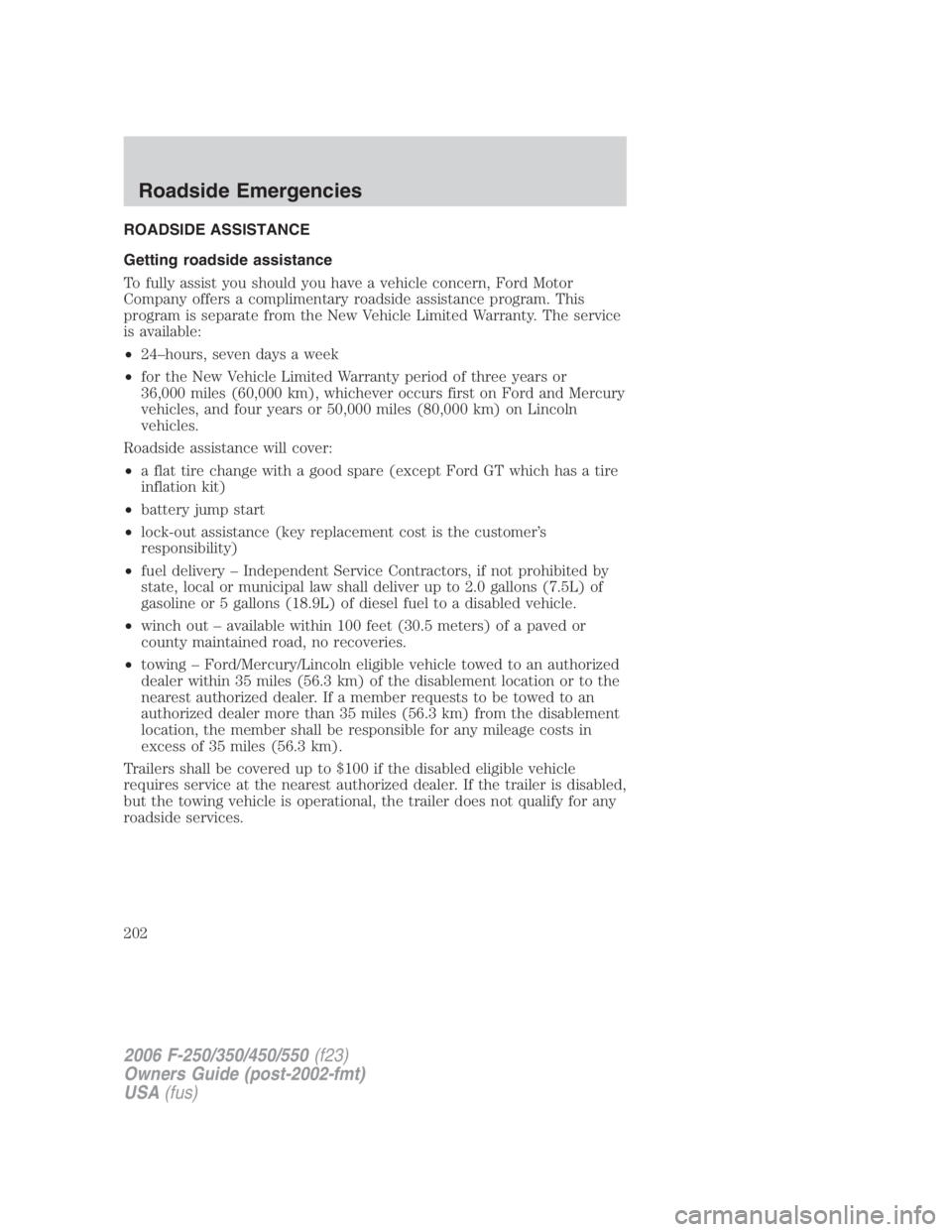
ROADSIDE ASSISTANCE
Getting roadside assistance
To fully assist you should you have a vehicle concern, Ford Motor
Company offers a complimentary roadside assistance program. This
program is separate from the New Vehicle Limited Warranty. The service
is available:
• 24–hours, seven days a week
• for the New Vehicle Limited Warranty period of three years or
36,000 miles (60,000 km), whichever occurs first on Ford and Mercury
vehicles, and four years or 50,000 miles (80,000 km) on Lincoln
vehicles.
Roadside assistance will cover:
• a flat tire change with a good spare (except Ford GT which has a tire
inflation kit)
• battery jump start
• lock-out assistance (key replacement cost is the customer’s
responsibility)
• fuel delivery – Independent Service Contractors, if not prohibited by
state, local or municipal law shall deliver up to 2.0 gallons (7.5L) of
gasoline or 5 gallons (18.9L) of diesel fuel to a disabled vehicle.
• winch out – available within 100 feet (30.5 meters) of a paved or
county maintained road, no recoveries.
• towing – Ford/Mercury/Lincoln eligible vehicle towed to an authorized
dealer within 35 miles (56.3 km) of the disablement location or to the
nearest authorized dealer. If a member requests to be towed to an
authorized dealer more than 35 miles (56.3 km) from the disablement
location, the member shall be responsible for any mileage costs in
excess of 35 miles (56.3 km).
Trailers shall be covered up to $100 if the disabled eligible vehicle
requires service at the nearest authorized dealer. If the trailer is disabled,
but the towing vehicle is operational, the trailer does not qualify for any
roadside services.
2006 F-250/350/450/550 (f23)
Owners Guide (post-2002-fmt)
USA (fus)Roadside Emergencies
202
Page 226 of 312
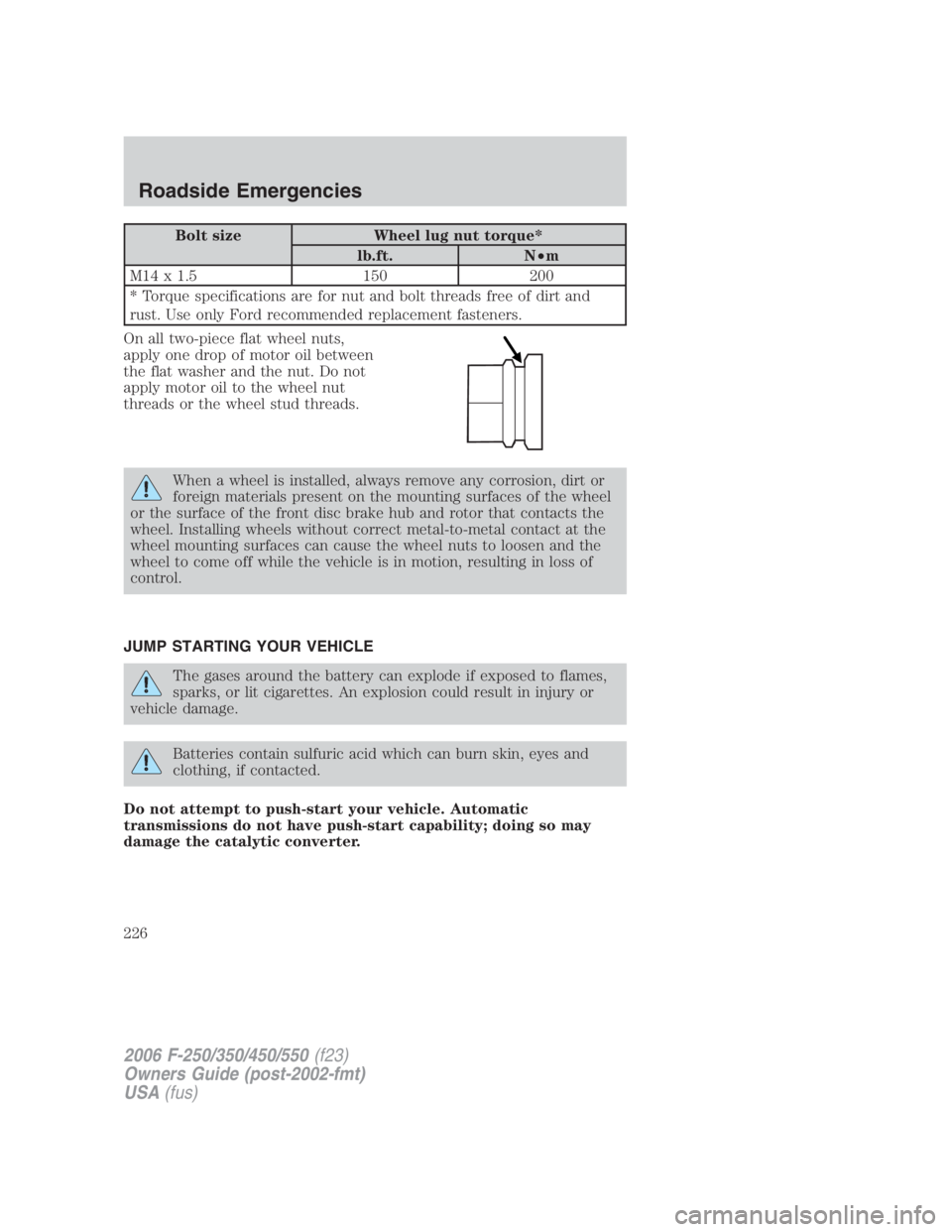
Bolt size Wheel lug nut torque*
lb.ft. N • m
M14 x 1.5 150 200
* Torque specifications are for nut and bolt threads free of dirt and
rust. Use only Ford recommended replacement fasteners.
On all two-piece flat wheel nuts,
apply one drop of motor oil between
the flat washer and the nut. Do not
apply motor oil to the wheel nut
threads or the wheel stud threads.
When a wheel is installed, always remove any corrosion, dirt or
foreign materials present on the mounting surfaces of the wheel
or the surface of the front disc brake hub and rotor that contacts the
wheel. Installing wheels without correct metal-to-metal contact at the
wheel mounting surfaces can cause the wheel nuts to loosen and the
wheel to come off while the vehicle is in motion, resulting in loss of
control.
JUMP STARTING YOUR VEHICLE
The gases around the battery can explode if exposed to flames,
sparks, or lit cigarettes. An explosion could result in injury or
vehicle damage.
Batteries contain sulfuric acid which can burn skin, eyes and
clothing, if contacted.
Do not attempt to push-start your vehicle. Automatic
transmissions do not have push-start capability; doing so may
damage the catalytic converter.
2006 F-250/350/450/550 (f23)
Owners Guide (post-2002-fmt)
USA (fus)Roadside Emergencies
226
Page 227 of 312
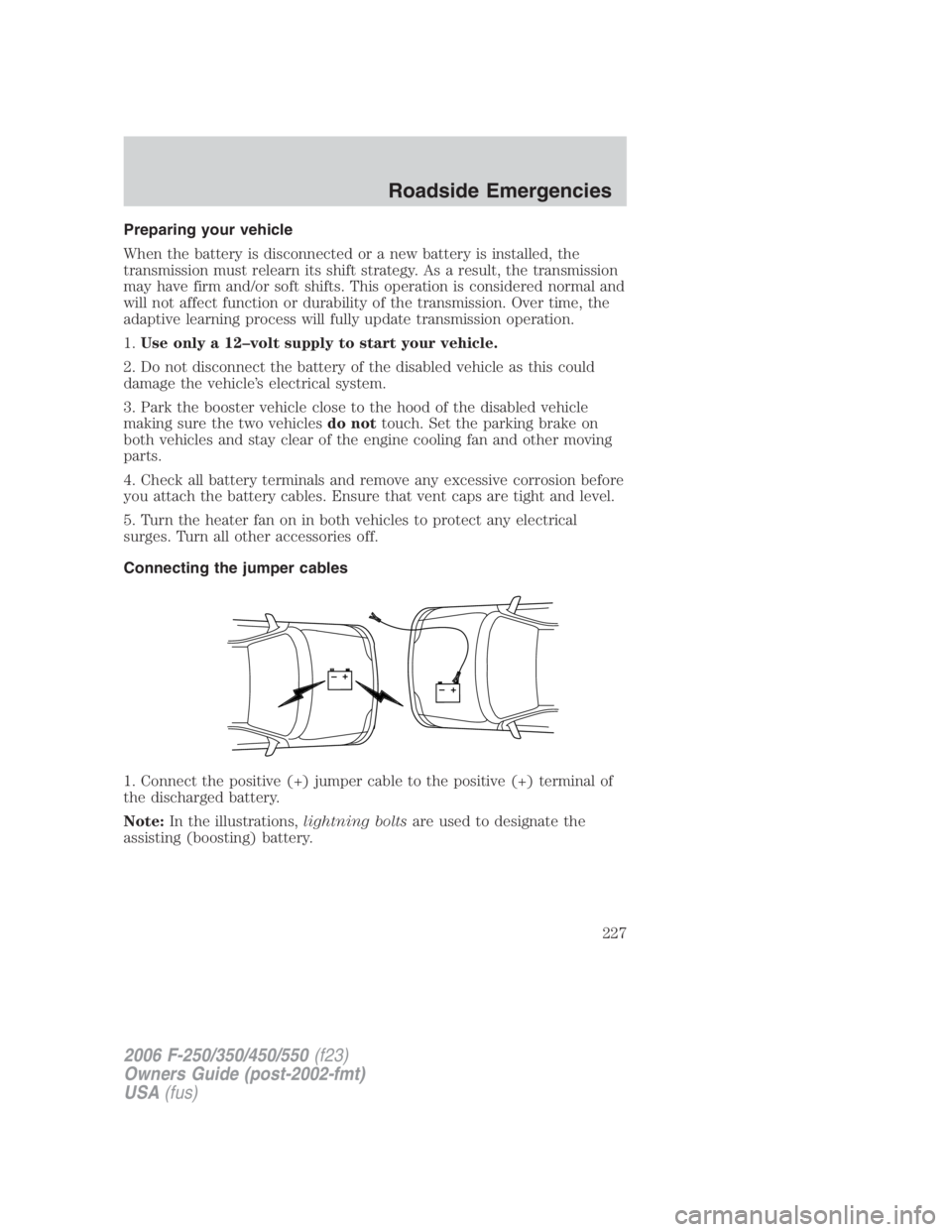
Preparing your vehicle
When the battery is disconnected or a new battery is installed, the
transmission must relearn its shift strategy. As a result, the transmission
may have firm and/or soft shifts. This operation is considered normal and
will not affect function or durability of the transmission. Over time, the
adaptive learning process will fully update transmission operation.
1. Use only a 12–volt supply to start your vehicle.
2. Do not disconnect the battery of the disabled vehicle as this could
damage the vehicle’s electrical system.
3. Park the booster vehicle close to the hood of the disabled vehicle
making sure the two vehicles do not touch. Set the parking brake on
both vehicles and stay clear of the engine cooling fan and other moving
parts.
4. Check all battery terminals and remove any excessive corrosion before
you attach the battery cables. Ensure that vent caps are tight and level.
5. Turn the heater fan on in both vehicles to protect any electrical
surges. Turn all other accessories off.
Connecting the jumper cables
1. Connect the positive (+) jumper cable to the positive (+) terminal of
the discharged battery.
Note: In the illustrations, lightning bolts are used to designate the
assisting (boosting) battery.
+
–
+
– 2006 F-250/350/450/550 (f23)
Owners Guide (post-2002-fmt)
USA (fus) Roadside Emergencies
227
Page 229 of 312
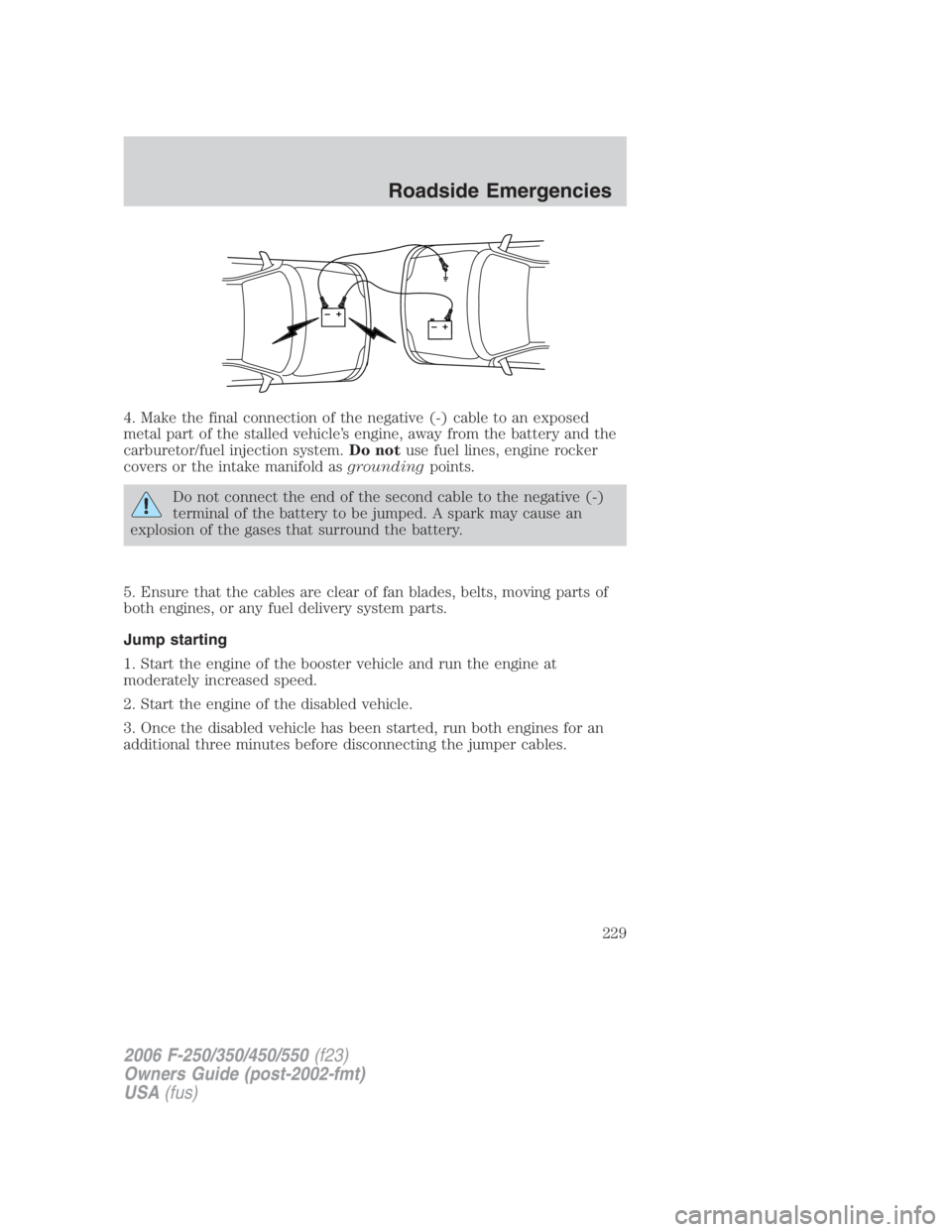
4. Make the final connection of the negative (-) cable to an exposed
metal part of the stalled vehicle’s engine, away from the battery and the
carburetor/fuel injection system. Do not use fuel lines, engine rocker
covers or the intake manifold as grounding points.
Do not connect the end of the second cable to the negative (-)
terminal of the battery to be jumped. A spark may cause an
explosion of the gases that surround the battery.
5. Ensure that the cables are clear of fan blades, belts, moving parts of
both engines, or any fuel delivery system parts.
Jump starting
1. Start the engine of the booster vehicle and run the engine at
moderately increased speed.
2. Start the engine of the disabled vehicle.
3. Once the disabled vehicle has been started, run both engines for an
additional three minutes before disconnecting the jumper cables.
+
–
+
– 2006 F-250/350/450/550 (f23)
Owners Guide (post-2002-fmt)
USA (fus) Roadside Emergencies
229
Page 231 of 312
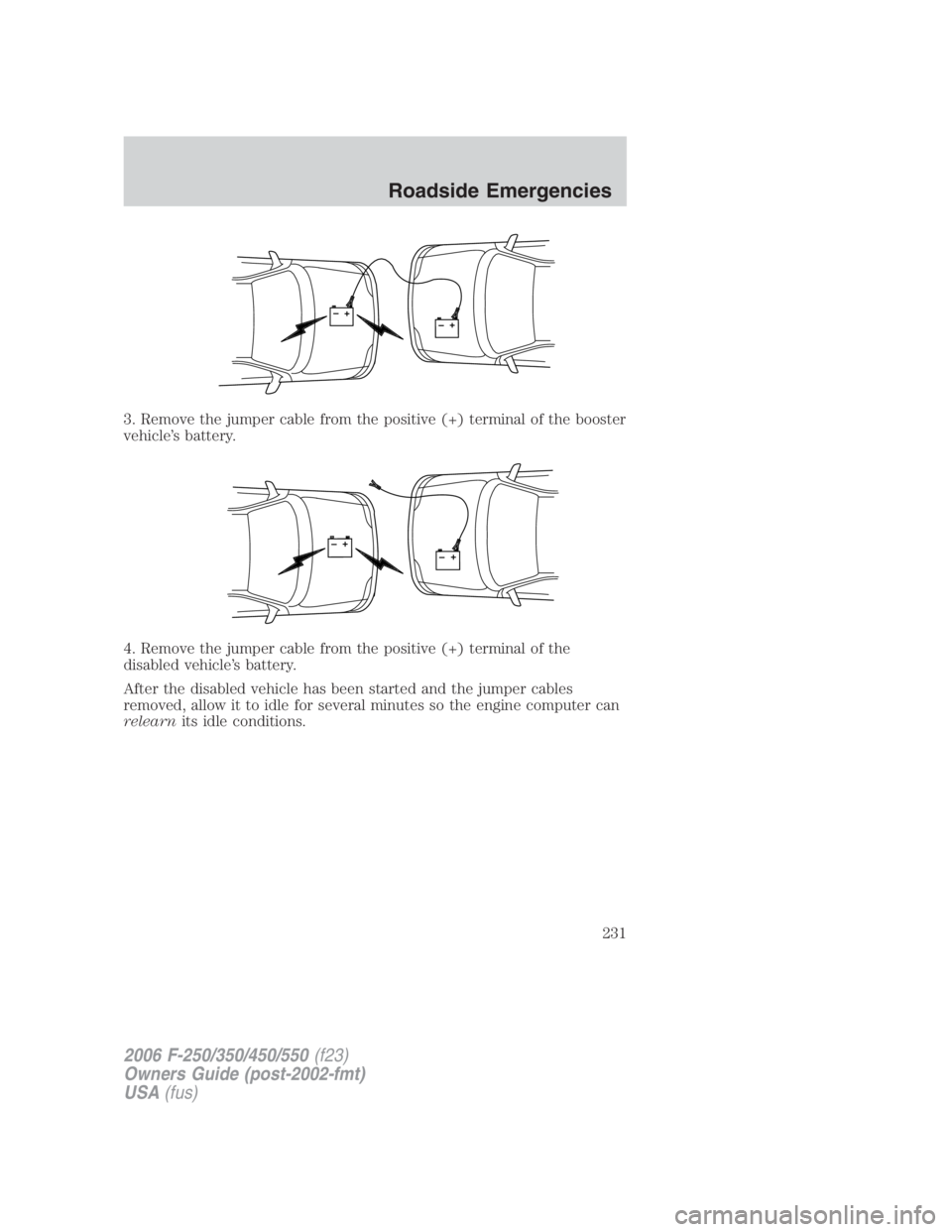
3. Remove the jumper cable from the positive (+) terminal of the booster
vehicle’s battery.
4. Remove the jumper cable from the positive (+) terminal of the
disabled vehicle’s battery.
After the disabled vehicle has been started and the jumper cables
removed, allow it to idle for several minutes so the engine computer can
relearn its idle conditions.
+
–
+
–
+
–
+
– 2006 F-250/350/450/550 (f23)
Owners Guide (post-2002-fmt)
USA (fus) Roadside Emergencies
231
Page 306 of 312
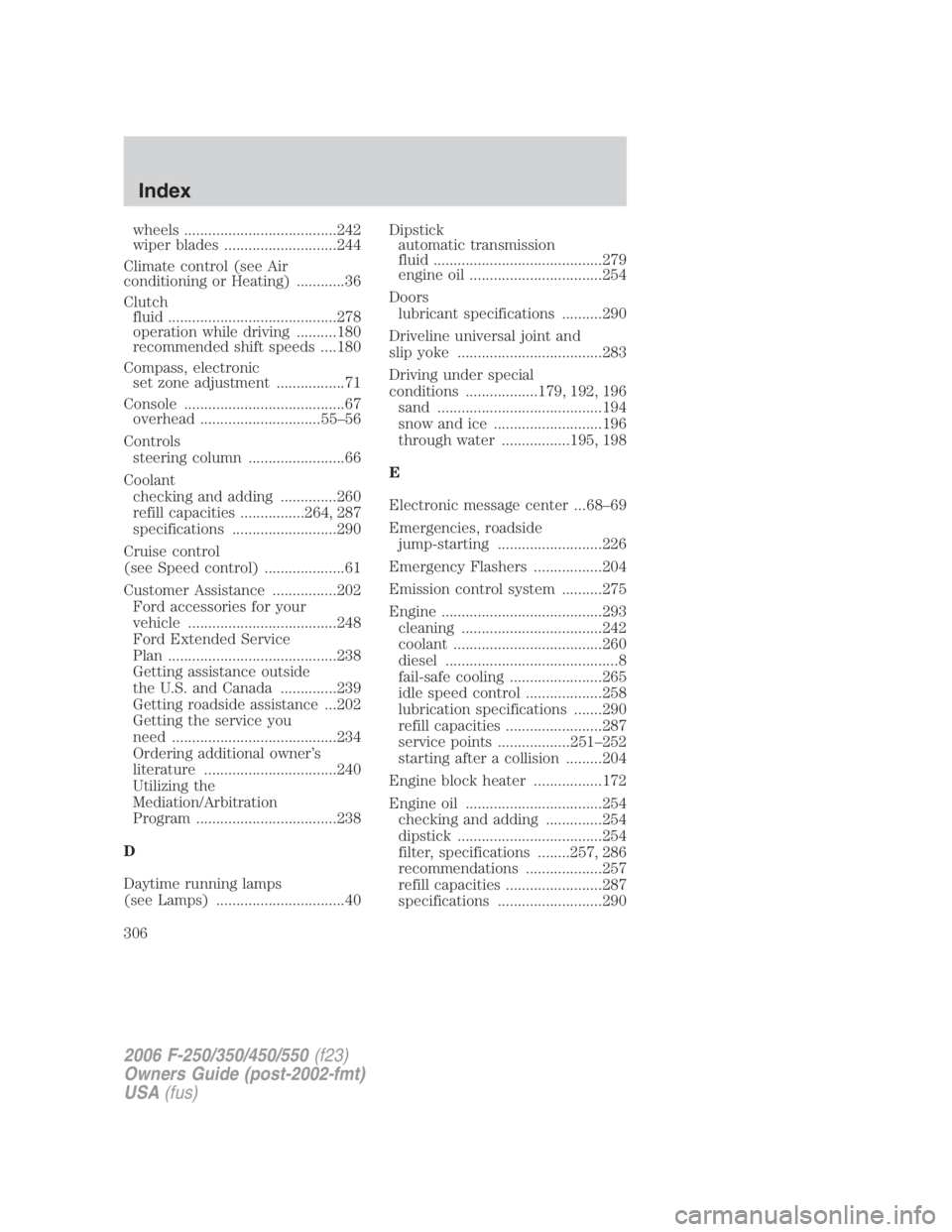
wheels ......................................242
wiper blades ............................244
Climate control (see Air
conditioning or Heating) ............36
Clutch
fluid ..........................................278
operation while driving ..........180
recommended shift speeds ....180
Compass, electronic
set zone adjustment .................71
Console ........................................67
overhead ..............................55–56
Controls
steering column ........................66
Coolant
checking and adding ..............260
refill capacities ................264, 287
specifications ..........................290
Cruise control
(see Speed control) ....................61
Customer Assistance ................202
Ford accessories for your
vehicle .....................................248
Ford Extended Service
Plan ..........................................238
Getting assistance outside
the U.S. and Canada ..............239
Getting roadside assistance ...202
Getting the service you
need .........................................234
Ordering additional owner’s
literature .................................240
Utilizing the
Mediation/Arbitration
Program ...................................238
D
Daytime running lamps
(see Lamps) ................................40 Dipstick
automatic transmission
fluid ..........................................279
engine oil .................................254
Doors
lubricant specifications ..........290
Driveline universal joint and
slip yoke ....................................283
Driving under special
conditions ..................179, 192, 196
sand .........................................194
snow and ice ...........................196
through water .................195, 198
E
Electronic message center ...68–69
Emergencies, roadside
jump-starting ..........................226
Emergency Flashers .................204
Emission control system ..........275
Engine ........................................293
cleaning ...................................242
coolant .....................................260
diesel ...........................................8
fail-safe cooling .......................265
idle speed control ...................258
lubrication specifications .......290
refill capacities ........................287
service points ..................251–252
starting after a collision .........204
Engine block heater .................172
Engine oil ..................................254
checking and adding ..............254
dipstick ....................................254
filter, specifications ........257, 286
recommendations ...................257
refill capacities ........................287
specifications ..........................290
2006 F-250/350/450/550 (f23)
Owners Guide (post-2002-fmt)
USA (fus)Index
306
Page 307 of 312
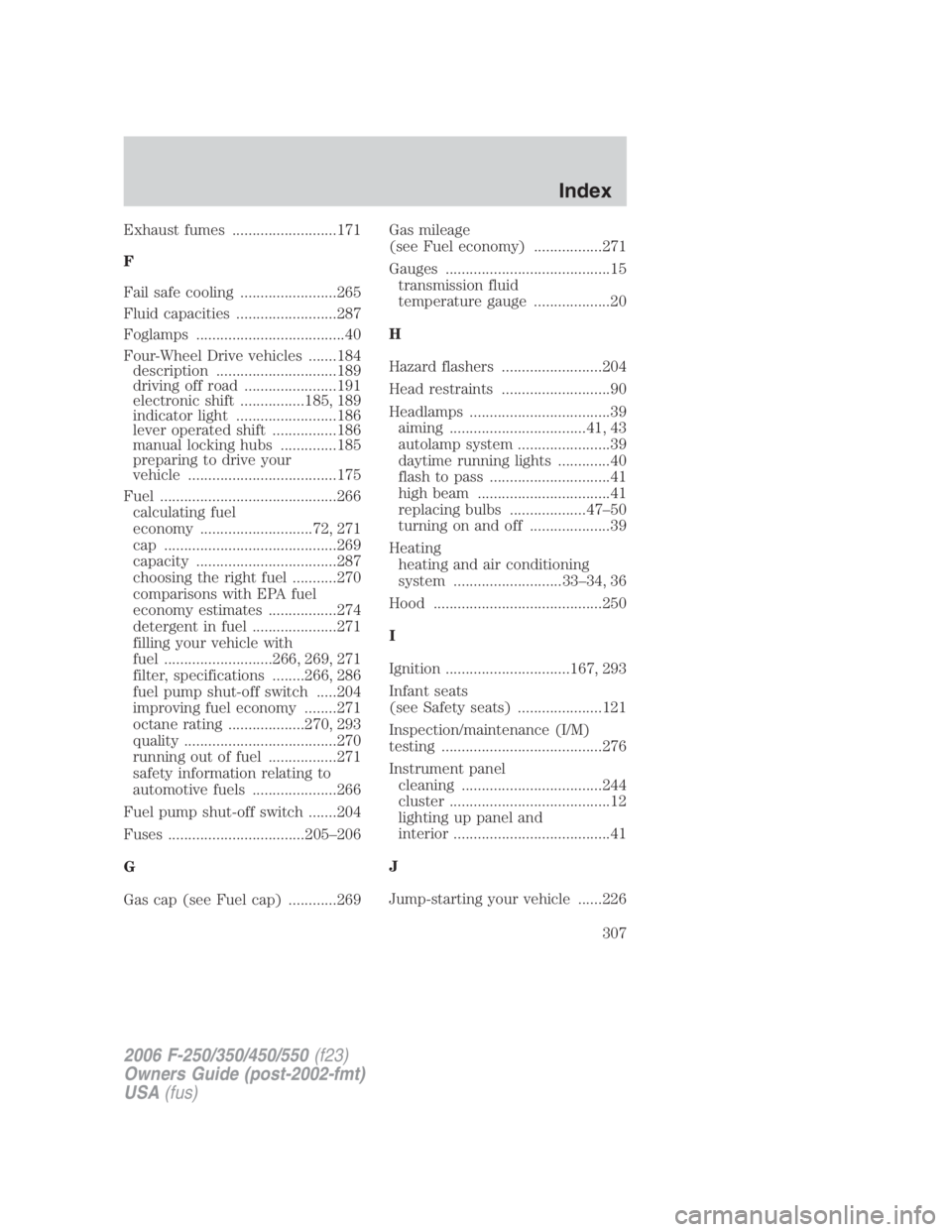
Exhaust fumes ..........................171
F
Fail safe cooling ........................265
Fluid capacities .........................287
Foglamps .....................................40
Four-Wheel Drive vehicles .......184
description ..............................189
driving off road .......................191
electronic shift ................185, 189
indicator light .........................186
lever operated shift ................186
manual locking hubs ..............185
preparing to drive your
vehicle .....................................175
Fuel ............................................266
calculating fuel
economy ............................72, 271
cap ...........................................269
capacity ...................................287
choosing the right fuel ...........270
comparisons with EPA fuel
economy estimates .................274
detergent in fuel .....................271
filling your vehicle with
fuel ...........................266, 269, 271
filter, specifications ........266, 286
fuel pump shut-off switch .....204
improving fuel economy ........271
octane rating ...................270, 293
quality ......................................270
running out of fuel .................271
safety information relating to
automotive fuels .....................266
Fuel pump shut-off switch .......204
Fuses ..................................205–206
G
Gas cap (see Fuel cap) ............269 Gas mileage
(see Fuel economy) .................271
Gauges .........................................15
transmission fluid
temperature gauge ...................20
H
Hazard flashers .........................204
Head restraints ...........................90
Headlamps ...................................39
aiming ..................................41, 43
autolamp system .......................39
daytime running lights .............40
flash to pass ..............................41
high beam .................................41
replacing bulbs ...................47–50
turning on and off ....................39
Heating
heating and air conditioning
system ...........................33–34, 36
Hood ..........................................250
I
Ignition ...............................167, 293
Infant seats
(see Safety seats) .....................121
Inspection/maintenance (I/M)
testing ........................................276
Instrument panel
cleaning ...................................244
cluster ........................................12
lighting up panel and
interior .......................................41
J
Jump-starting your vehicle ......226
2006 F-250/350/450/550 (f23)
Owners Guide (post-2002-fmt)
USA (fus) Index
307